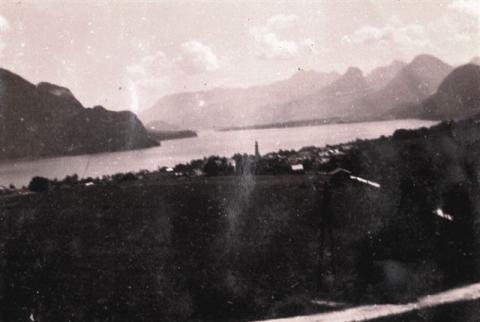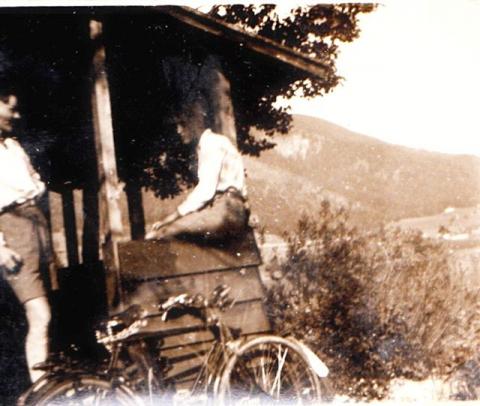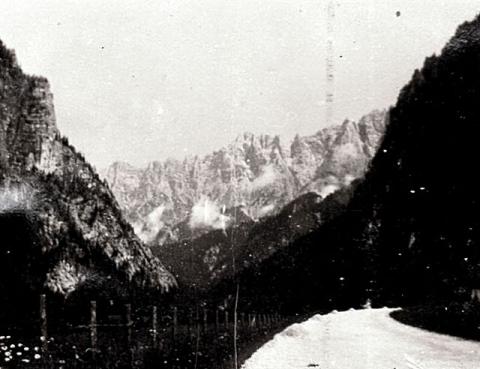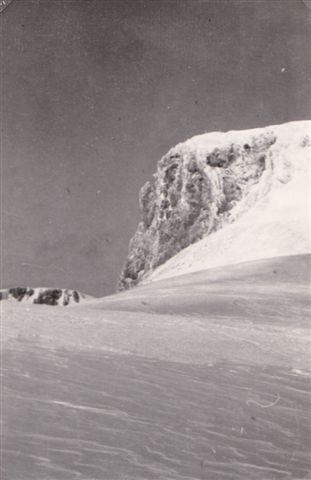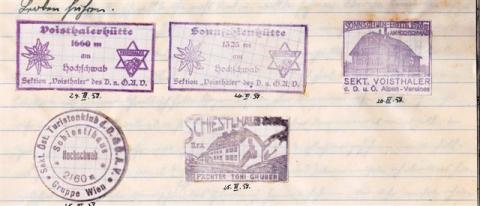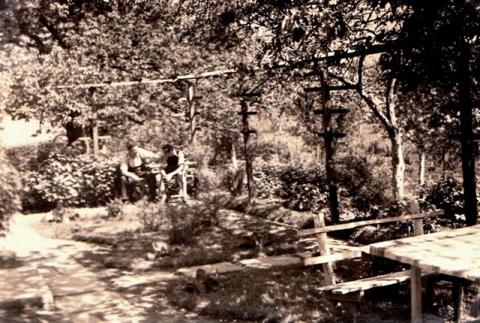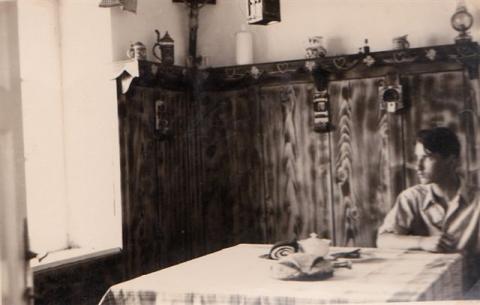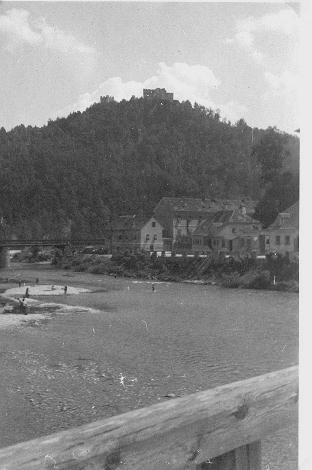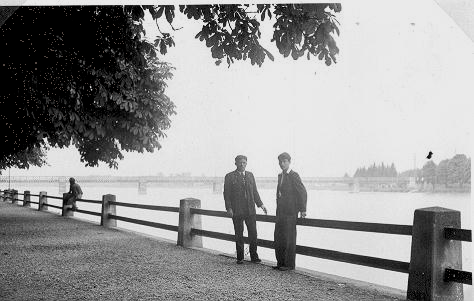Bicycle Adventures of an Austrian Teen
From Leopold Wenger's Trip Diary
Out and About on the Bicycle
1936-1937
copyright 2013 Wilhelm Wenger and Carolyn Yeager
Translated from the German by Wilfried Heink
Leopold Wenger was born on Nov. 19, 1921; in July 1936 when his first diary-recorded bike trip began, he was only 14 years old. By the time of the rest of the trips recorded here (all of which took place before the annexation of Austria to Germany), he was 15 years old. Quite a responsible, resiliant, hardy and adventurous young National-Socialist "Hitler Youth" he was, who later became a valiant defender of the Reich. My thanks to Willy Wenger for sending these diary entries to me – along with the photographs taken by 'Poldi (called Bibi by family) – and to Wilfried Heink for translating it from the German original – a large undertaking.
While this may not interest everyone, I believe it is of great value for comparing our youth of that time with our youth of today. -cy
P.S. On 6-5-2016 I linked the images to the file view, so just click on them for a larger view.
The Salzburg Journey, May 5-8, 1936
Sunday, July 5, 1936. We were to leave Leoben at 5:30, but I slept in and was picked up by Prommer and Horvat; we left Leoben at 5:45. We traveled via Edling to Seitz. Between Kammern and Mauten, we had to stop for the first time, my canteen/flask, fastened to my rucksack had slipped between the frame of my bike and the hind wheel during a descent. It acted as a brake, and the felt encasing was severely damaged.
The first rest stop was at the Schober summit. We arrived in Liezen at 12 noon in time for lunch. It had been extremely hot all morning. Past Steinach-Erdning we left the main road, pushed our bikes for one and a half hour over the Klachau pass and arrived in Bad Aussee at 16.45. We rested for awhile and at 17:00 we started to push our bikes to the Koppe, a very narrow pass used as a shortcut to Hallstadt. At about the border between Styria and Upper-Austria the road reaches its highest point, to the right a canyon used by the railroad. The road was in horrible shape; a car could never have driven through here. There were also warning signs posted: "Bicycle riders dismount, very steep grade, avalanche danger!"
At 18:00 we arrived at the Hallstätter Lake and started to look for a place to camp. We asked a farmer and he showed us a spot. We cooked tea on a camp stove and ate sardines and sausages (from Hovarth). At dusk, we prepared our bed site, watched some ships on the lake all lit up, and went to bed at 8 o'clock. We had encountered a strong head wind all day, the day had been warm, there were no mechanical defects worth mentioning.
Town of Saint Gilgen on Lake Wolfgang
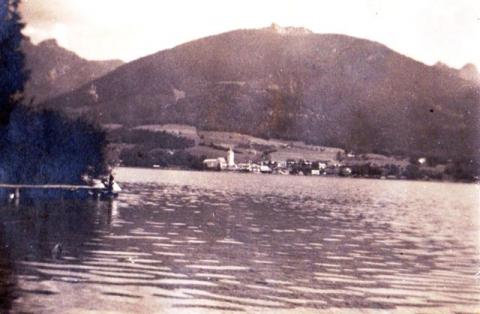
Saint Wolfgang on the Wolfgangsee
Monday, July 6, 1936: We woke up at 4:15, a short run took us to a well for washing. After preparing breakfast (lemonade), and cleaning of the site, we left at 6:30. The journey took us through Hallstadt, Goisern to reach Bad Ischl at 7:30, where we purchased camp stove fuel and bread. We did not stay long and at 8:15 we had our first glimpse of Saint Wolfgang Lake, but did not enter the town.
We camped across from the Inn “weissen Rössl” (The White Horse Inn, made famous in an operetta), went swimming and watched a great crested grebe for the longest time. At 12:00 we continued our journey to soon reach Saint Gilgen, atown with beaches, sailing as well as motor boats, steam ships, etc. Then we had to push our bikes again and, when we descended toward the Fuschl Lake, I lost Horvat’s jacket which had been fastened to my rucksack. At 3:00 we arrived at the lake and camped at the shore. Horvat and Prommer killed a snake, probably a grass snake which was just eating a fish. Some fishermen were fishing with nets.
We rented a boat and spent an hour on the lake, almost running into a woman’s head. She was wearing a big straw hat which we mistook for floating debris. We then again swam for a while, to later prepare supper (cocoa cooked with water and marmalade). We then tossed a few floating objects into the lake and aimed at them with rocks until it was too dark. At 9:00 we bedded down on the veranda of a nearby bathing hut, the floor was extremely hard but we were dead tired and slept well. The weather had been good again, just like on the previous day and no mechanical defects either.
Tuesday, July 7, 1936. At about 4:30 Prommer woke me, he and Horvat had been up for a while. I quickly washed in the lake and then cycled to a farmer for fresh water. We again cooked tea and left at 5:00. At first we had to push our bikes again, then downhill and up again. It was extremely hot and the sweat just poured from us, we of course had taken our shirts off a long time ago. We were very thirsty and drank a lot of water to help cool us down.
After pushing our bikes up the Gaisberg, we could see the city of Salzburg in the valley. A joyful descent started on twisting roads, passing a few cars to soon reach the bottom. At 9:00 we could see the Castle, we traveled through town, visited the house in which Mozart had been born, as well as the Cathedral. We then made a side trip to Hellbrunn to watch the trick fountains, view the Palace, the zoo, as well as the park of the Emperor. We then mailed a few picture postcards, and at 12:00 sharp we left Salzburg, following our three hour tour through the city.
 Right: View of Salzburg castle -enlarge
Right: View of Salzburg castle -enlarge
We stopped for lunch at the crest of the Gaisberg. We had just started going downhill when Prommer caught a rock in his rear wheel, it only took him fifteen minutes to fix it and we continued our journey. In Hof we turned north to reach Thalgau on a steep and bad road, to then reach Mondsee. A few kilometers on, the tire on my rear wheel suddenly went flat. I couldn’t find a nail in the tire; I therefore assumed that it was the valve, and exchanged it, but that wasn’t it. A thunderstorm came up, it started to rain but to our luck a farm was nearby. The farmer gave us permission to fix the bike in the barn, I finally found three holes in the tube and repaired it. The rain was coming down hard now, so all we could do is wait. It would have been a comfortable wait if not for the many flies.
By 6:30 the rain had stopped and we continued our journey, and we decided to make up for lost time by travelling at night. The road along the Mondsee was carved out of the rock; we often had to ride through tunnels, reaching See at 7:00. Then to Atter Lake and along its shores to Weißenbach, marveling at the size of the lake. After that through a forest to the Gmunden-Ischl road.
Right: We spent the night in a woodshed. enlarge
It was now getting dark, we needed to turn on our lights before we even reached Ischl. Horvath was in the lead, his light produced by a dynamo, then Prommer and me with our flashlights; we only turned them on when someone was on the road. It took awhile to go through Itschen, we got lost, but finally reached Goisern at 22:00hrs. We rested for a while, cooking cocoa. At 23:00 we continued and reached the foot of the road leading up to the Pötschen pass at 23:30. Here we found a wood shed, we entered, cleaned it up and bedded down, falling asleep almost immediately. The night travel had been strenuous. No wind during the day, the weather nice at first, then rain, and we also had some mechanical problems.
Wednesday, July 8, 1936. The Pötschen pass road was steep from the beginning. After a half hour pushing our bikes we were half way up and had breakfast in a restaurant, every one consuming a liter of milk. We had our first view of the Dachstein. When we reached the pass at 6:30 Horvat was stopped by a policeman; he had no stoplight. The road down to Aussee was in good shape, we made good time and arrived in Lietzen at noon. We were about to get off our bikes when Horvat was hit by another biker; the damage was slight.
We had our lunch in a restaurant, goulash from a can, sausage and bread, accompanied by apple cider, which made me tipsy. A thunderstorm with strong winds surprised us, we were sitting in the restaurant garden and had to seek shelter in the house. At 3:00 we could continue, the street was a mess, torn off branches as well as mud. We reached Hiflau at six in the evening, it had hailed. We arrived in Eisenerz at seven, tired, but we still had to make it up to the Pöbichl pass, a three-quarter of an hour climb we were told, wrongly.
We were half way up when a thunderstorm suddenly appeared; Horvath was behind but Prommer beside me. I yanked my jacket out, lost my hat and was drenched in minutes. We took shelter under some trees, and when the lightening stopped we looked for Horvath in pouring rain. He had found shelter in a wood shed, we changed clothing and decided to stay if the rain didn’t stop.
I just had taken off my wet shirt when we hear a motor vehicle approaching, my comrades jumped out to stop the van of a well known Leoben merchant. The driver agreed to take us, and we made it to Donawitz in reasonable comfort. Prommers landlord took him and our rucksacks, Horvart and I arrived back in Leoben at 20:30.
The weather had been lousy all day, delaying our journey, we also had a small mishap. I spent the most money, 6 shillings.
The kilometers traveled on each of the 4 days: Day 1, 36km; Day 2, 64km; Day 3, 132km; Day 4, 151km.
Rushing water and steep roads in the Gehäuse National Park, Styria
Präbichl-Polster, March 6-7, 1937
Saturday, March 6, 1937. I arrived home at 13:00, packed my bags, fastened my skis to the bike, Wurschitz was to pick me up at 14:00 but arrived late and we had to hurry to reach Präbichl before dark. At 16:25 we were in Vordernberg, snow was still on the road; my bike was defective so we shouldered our skis and started the climb up the Präbichl road. We were hungry and stopped to eat some buns. Not an easy climb, a strong wind blowing snow into our faces. We took a shortcut and reached the German and Austrian Alp Club youth lodge sooner than expected. A young man had already arrived, soon more came.
And we went to work, chopping firewood, building a fire to cook tea. More people arrived, 20 in all. We drank tea, sang songs, filled our bellies, to finally bed down at 23:00, covering ourselves with everything we could find.
Sunday March 7, 1937. I woke up at 7:00, the sun was shining through the window already.
After folding the blankets, we washed in an icy trough; the tea was delicious. We waxed our skis, each praising his wax. My shoes were still wet but I had no choice but to wear them.
The first boys who had taken the train started to arrive, and the first competition was to start before noon. The weather was nice, the snow conditions varied, with drifts. The downhill race was spread over two slopes, the first rather easy, the second steep. 5.3 min was the best time, 13 min the worst.
For lunch we had pea soup with sausages, then some of us rested while other engaged in a snowball fight. The sun was gone and in the afternoon a patrol exercise was planned: Downhill then cross country. Our group came in third. At four we were getting ready to leave, we skied down to Vordernberg, I fixed my bike and was home in little more than an hour.
Easter at the Hochschwab, March 24-27, 1937
Wednesday, March 24, 1937 Departure from Leoben at 7:30, when I arrived at the train station everyone was there already. We changed trains in Bruck an der Mur, then travelled to Au in a motor tram and all nine of us … marched to Seewiesen (7km). There we had a short break. We tried to purchase some bread but only found half a loaf.
Soon we were able to put on our skis, making things easier. We watched chamois (a goat-antelope species native to the mountains in Europe), some close by. It was overcast, snowing, the mountains in fog. We had lunch at the Forschel-Alm, then on to the French Cross (the French had allegedly advanced to here). Then downhill, again many chamois, and suddenly the Voitstal hut appeared from the fog.
Following another short lunch break we made a trial run down the slope; Scherabon broke the tip of one of his skis. A storm came up and we returned to the hut, the wind blowing strongly up here. We met Prof. Müller, had supper, sang some songs and went to sleep. I took a peek outside, it was very stormy, some men trying to reach Schiestl house had to turn back. We could hear the wind howl all night long.
Thursday, March 25, 1937. We had hoped that the storm would subside, but we were wrong. Right after breakfast we started our climb, the wind becoming stronger as we climbed. We experienced some equipment problems and if it would not have been for the long poles, placed along the way, we surely would have gotten lost.
We were covered in ice. I tried to drink from my canteen; I had filled it with hot tea but it was frozen. Shortly before reaching the high plateau, we almost missed a crack, but Prof. Porsche changed course just in time. At the plateau, the wind had reached hurricane strength, we had to stop repeatedly but I was blown over a few times just the same. Our faces were numb and at noon we reached the Schiestl-House (2,160m).
We spent the rest of the day playing cards; toward evening the storm subsided, the fog lifted and we ran to the Hochschwab-Western-Wall (400m high). After supper we bedded down.
Friday, March 26, 1937. The storm had subsided, and after breakfast we continued our climb. We had to climb some 117m, without skis, the snow was too icy. Finally some sun; an icy wind was blowing at the summit, freezing the ink in Prof. Porsche’s pen while he was trying to enter our names into the summit register. We walked down the icy southern slope, we were only able to put on our skis half-way down. We passed many signs with the inscription: “Frozen to death during a snowstorm.”
The snow conditions improved, we fell more than walked down a steep embankment and reached the Sackwiesen-Alm at noon. Fog had come up during the morning, but the high marking posts guided us. Now the sun was shining, the view was great.
Uhrmann and I dug a hole in the snow, found some brush, laid down and baked in the sun. But clouds came up and we continued our march, and at 16:00 we reached the Sunshine-Hut. After something to eat we decided to climb up to the Ebenstein (photo right), fearing that the weather would turn bad. Three remained behind, I continued of course, had some problems with my skis, took them off but caught up with the others again. Soon the others had to take their skis off also and we left them further up the slope, having secured them first.
The last part we did using our poles for support, not an easy task, the rocks were loose and covered in ice. An icy wind was blowing at the summit; we noticed a cross, a man had committed suicide here. All of us signed in at the summit registry, no one had been up here for weeks.
We met two people from Leoben - Dermutz and Domschütz - at the spot where we had left our skis; they suggested a wager, boasting to reach the hut before us, even though they still had to make it up to the summit. We waited until we could see them returning, and then left, skiing carefully at first but later on straight down. I lost control and crashed, the worst fall ever. Luckily I had given my camera to Prof. Porsche, or it would have been destroyed.
I caught up to the others again and made it down without further problems, and we did beat Dermutz and Domschütz who arrived shortly after us. We spent the rest of the day and evening in our rooms, only going out before bedtime to see a beautiful full moon.
Saturday, March 27, 1937. It was snowing, but we nevertheless decided to climb the little Ebenstein. We had to turn back however; it was snowing too much. About 10:00 we left for the valley. We had fun skiing down, all of it seemingly more dangerous than it was. We arrived in Tragös, had lunch at the green lake, with Prof. Porsche cooking tea. We then climbed via the Hiesl-Corner to the Rötz-Trench, a seemingly endless route. We just made the train in Trofaich.
The stamps of various Alpine-Clubs as collected by Bibi
The Pentecost Journey, May 15-18, 1937
Saturday, May 15, 1937. The morning was extremely hot already and since there was no school I went for a walk in the forest, returning at 12 noon. After lunch I packed my bag, fastened it onto the bike but discovered that the rear wheel was flat, a nail protruding through the tire. I fixed the flat and left Leoben in the direction of Graz. I had forgotten my map but did not return, arriving in Graz at 5:30pm. I had to push my bike up to Ries, then downhill to Gleisdorf and a little later I had to turn my lights on. I almost fell asleep and was hungry, so I decided on a short break, did some pushups and after a few buns and water I continued my journey. Again on foot up the Dachsberg, passing the big slide, then quickly through Klausen. The last stretch was slow going, gravel road and my tire was worn, the air almost gone out of the tube. I arrived home at 8:30pm; my Dad, who had arrived by train an hour earlier, was waiting for me.
Pentecost Sunday, May 16, 1937. I woke up late, I was still tired and since I had no plans for the day I helped Dad, resting in the afternoon.
With Dad in the garden
Bibi in the kitchen.
Pentecost Monday, May 17, 1937. I had to go to town hall in the morning, and on the way back my tire went flat in a few seconds; I had a hard time stopping. Because of the tire being worn, the tube stuck out on places, and a big hole was the result. I had no patches along, but found a used tube in a store and was able to continue. At 2pm, after lunch, I started for Graz and made good time but near Gleisdorf my tire went flat again. I exchanged the valve, that didn’t help and I finally noticed that the patch I had applied in the morning had come loose. After an hour I could continue, reaching Graz at 6pm, staying over night at Grandma's. My arms were sunburned and hurting.
Tuesday, May 18, 1937. At 6am, after breakfast, I left for Pack (a municipality in the district of Voitsberg -cy). It took awhile to find the right road. I liked the road from Graz to Tobel and the latter a nice place, a spa town. I purchased a few rye flour buns at Voitsberg and later rested a little. I got lost again at Köflach because I had no map and had to return. From here on I had to push the bike often, took what I believed to be a shortcut through a forest, a mistake as it turned out. It was extremely hot and the last stretch to Pack took one and a half hours, pushing my bike. At 11am I passed the big silver cross and a little later the border to Carinthia. I had to stay on the right side of the road now, but decided not to take the Pack road, as I would have had to backtrack.


Left: Resting at The Pack. Right: A look back at the Styria side of The Pack.
The Pack road looking at it from the Carinthia side.
I took a break right at the border and then continued downhill, not used to traveling on the right side but I managed. The road was good and I reached Twimberg at 12 noon, but now the road deteriorated; it was also going uphill again. It was market day in St. Leonard and I passed Reichenfels. I again passed the border into Styria at 1:45pm. Soon after I had to climb the last hill, but the ride to Judenburg was great; I never had to peddle. Just outside of Knittelfeld, I ate my last bread; I had never been in this region.
The ride to Leoben went well, arriving just before 5pm. My front wheel came loose just before home, but I did make it. This was the only problem all day with the bike.
Daily mileage: Day 1, 130km; Day 3, 60km; Day 4, 166km
Summer holidays 1937
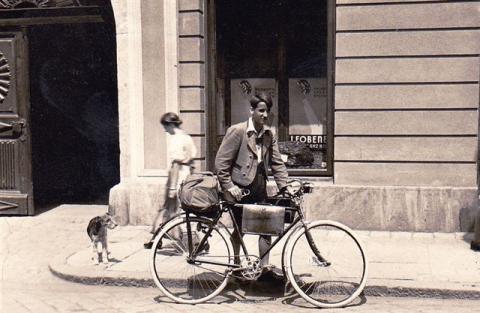
Monday, July 5, 1937. Mom, Willy and Gretl had already left when I readied my bike - the touring club banner on the handle bar, my backpack on the rack and a bag fastened to the frame, I must have looked quite adventurous. I left at 11am, Dad took a picture, stopped for a short time in Mühltal to chat with some boys I knew, and then away in a hurry. Dad passed me on his motorbike, waving, and at quarter to twelve I was in Pernegg, to stay with uncle Fritz. When I leaned my bike on the wall, I heard a loud hissing noise, the air leaving my rear tire.
Right after lunch I started to fix my bike, admiring the new tires Dad had bought, but then I found a large cut in the tube, the tire itself however was not damaged. I have no idea how this could have happened. At 4pm I was finished, too late to go swimming but, in spite of it all, I felt lucky that this happened at my uncle's place and not along the road somewhere.
Tuesday, July 6, 1937. I got up at 6am and left at 6:45, packing some potatoes and other goods for Grandma in Graz, received from aunt Leni. At a quarter to 9:00 I arrived in Graz to meet Mom and both of us went to the consulate. At 2pm Mom, Gretl and Willy left; I toured through Graz in the evening, viewing it by light. But my tire went flat again; someone might, while I was in the consulate, have pushed a pin into it.
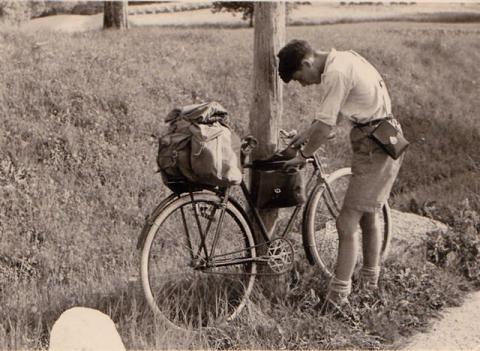
Getting ready for the downhill ride, after pushing the bike up the Riesenhöhe in eastern Styria.
Wednesday, July 7, 1937. I again got up at 6am to leave at 6:45, getting up the Ries was hard, but once on top I had fun. I rested for a while to travel to Gleisdorf; from there on the road was in bad shape (repair work). At a quarter to ten I arrived in Feldbach, from there over the Dachsberg to Gleichenberg, and at 10:15 I arrived at our house. It looked terrible, the grass high, no flowers to be seen, the floor coverings in the house moldy, the place had not been aired out since Pentecost. I borrowed a sickle from Great-Grandma, as well as some other garden tools, and went to work.
After lunch I continued, worked ‘till five, only then did the place look presentable again. At seven it started to rain, a thunderstorm, it did not last long. The day had been hot, but now I’ll quit, I need to study the maps yet, good night!
Thursday, July 8, 1937. Another thunderstorm at night, I woke up past six, cooked some cocoa, and after things were cleaned up, the key returned to Great-Grandma, it was 7:30.
Right: Leaving our Gleichenberg home after cleaning up.
-----------------------------
I left towards Straden, but circled around the town to not have to push my bike, the road to Mureck was in bad shape. From here the road was paved, I marveled at the arrangement of the farms, their cleanliness. When Straß came into view, the road branched off to Spielfeld. I had travelled along the border from Mureck to Spielfeld. A remarkable scenery on this side of the Mur in Austria - flat land with the occasional small forest. On the other side, in Yugoslavia, hill country. The Mur disappointed me, I had imagined it wider.
Then the border. First the Austrian customs - I had to hand my pass, as well as my trip itinerary over; I received a bike permit, along with other formalities and only then was I allowed to proceed to the Yugoslav side. The customs officer, an older man, spoke Slovenian but when I answered in German he also switched. In the station my pass was stamped, my itinerary checked, the baggage checked and that was it.
I was now allowed to travel on, but had to ride on the right side of the road, very confusing for me. The roads were bad; just before Marburg I had to climb the Leiterberg and then downhill. At the Marburg train station someone called out to me; it was Willy. He had waited for some time for me to arrive, to take me to Aunt Hilde’s new flat; I would never have found it. At five past ten I was home, only then I noticed that I had lost my flask.
No mechanical defects on the bike, all went well. In the evening we went to the movies, returning around one.

Willy and me, the Styria hills in the background.
July 9 and 10, 1937. Raining mostly, we stayed home.
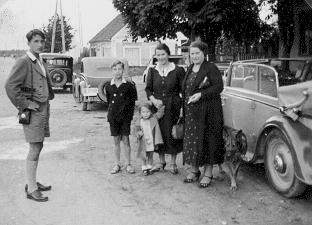
In St. Nikolai with siblings, mother and aunt.
Sunday July 12, 1937. Before noon the weather was not good, but improved later. Uncle Emil had rented a car and we travelled to St. Nikolai for lunch.
13th and 14th, 1937. Nothing special.
Thursday, July 15, 1937. At 2:30 I left our aunt's place, with no real purpose in mind, at first traveling along the same road as with the taxi a few days ago. The road was straight but in terrible shape, full of potholes. I passed through some small villages, the houses built of clay with straw roofs, poor peoples' places. At 3:00, I arrived in Pettau, the castle and church visible for a while already. The roads in town were paved with cobblestones, very rough going. I passed by the church with the free standing tower, allegedly built by the Romans - a watchtower with figurines carved in, some thousand years old. I left at 3:30 and arrived back in Marburg at 4:30.
Friday, July 16, 1837. I left again at 1:30, this time toward Windisch-Feistritz. I left the main road In Hoce, peddled and pushed up a hill, to then turn back to enjoy the downhill journey. Down below I could see Marburg. I then turned toward Windisch-Feistritz and had to push my bike up two hills before reaching the village. I had lunch in a restaurant, returning the same way I had come, arriving back at 5:30.
* * *
Thursday, July 29, 1937. I again travelled to Windisch-Feistritz, but turned off before I reached it to make my way toward Pragersdorf. I had to wait for a train to pass, and when I started out again I realized that I had taken the wrong turn, but I finally reached Cirknice. Leaving the village I entered the flat Pettau field and could vaguely see the Boc and Donati mountains in Croatia. I had to cross the rail line Pragersdorf-Pettau several times to finally make it back onto the main road. A nice ride to Pettau, forests on both sides of the road. Going through Pettau to look for the road to Warasdin, I had to stop to tighten a nut on my pedal, only to later turn around. Going back on the same road I had taken on July 15, I returned to Marburg.
Right: The Drau River near Cilli
With Dad on the shores of the Drau near Pettau
Thursday, August 5, 1937. I left Marburg at 9:30 on the road to Windisch-Feistritz again, then towards Ganobitz. I caught something in my eye, unable to remove it I was able to only see with the other. I witnessed a cavalry maneuver by the Yugoslav forces, then over two hills. The road went almost straight up, making it hard to climb, and downhill one had to be extremely careful. I made it to Gonobitz and after I had passed it, uphill again. I rode at first, but it was too hot, so I dismounted and pushed the bike. I rested under a tree and after reaching the crest it was steady downhill, passing many sawmills. At 1:00 I was still 9km from Cilli, but made it in half an hour. I crossed the Sann river, it looked like a bathtub, full of people. I noticed the ruins of the Cilli castle, then passed the Hotel Union, a beautiful structure, formerly the “Deutsches Haus”. I spent half an hour, then started the return trip. Half way up the hill it started to rain, but I just kept on going and was soon out of it. A short rest in Gonobitz, then to Marburg, home at 6:00.
Sunday, August 8, 1937. At 6:15 I left Marburg, this time with all my luggage, the Turner lake in Carinthia the destination. It was cold, I travelled the Rau upwards, passed castle Wildhaus to Zellnitz. Then along the Drau, uphill, downhill, I stopped for a rest before reaching Mahrenburg, then to Drauburg. Here I left the main road in the direction of Prävali, the dust on the road was inches deep. At noon I reached Prävali, but did not stay there but travelled on to pass the Petzen for the second time.
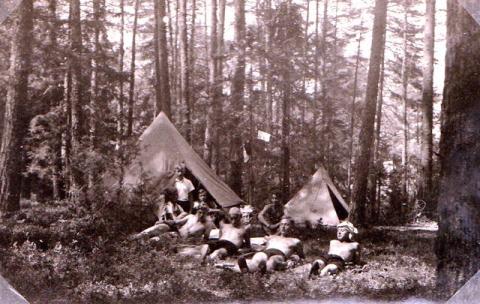
Illegal Hitler Youth camp at the Faaker Lake in Carinthia.
Past Prävali I had to push my bike up a hill and suddenly I was at the border, but the inspection was very relaxed, I did not even have to open my rucksack. Then through Unter-Loibach, past Blechburg and St. Stefan to Eberndorf. I noticed that all signs were in two languages, German and Slovenia, in the middle of German territory!!! I had to search for the Turner Lake, but found it, the shores all swampy and in the background the Karavanks, breathtaking.
Saturday, August 14, 1937. I stayed for almost a week in this beautiful region and met a few young men I knew. One of them joined me on my way back to Leoben. We left at 6:00, passed the Klopeiner lake on a lousy road to Kuhnsdorf. The road conditions improved and after a short climb downhill to the Drau, quite narrow already.
Past the bridge we had to push our bikes uphill, to Völkermarkt, reaching it at 7:45. We viewed the war memorial, then to Griffen, the ruins of a castle glued to the mountain side, visible from the distance. Past Griffen, up a steep, seemingly endless hill, and it was very hot, then carefully downhill to Tabakfastl and uphill again. A truck passed us slowly, we latched on to it and reached the crest with relative ease. Downhill again to St. Andrä, passing through at 10:00.
Now our stomachs started to growl, we had nothing to eat since 6:00, aside from a few apples. We planned to do some shopping at Wolfsberg, marveling at the castle from afar. Through a park-like setting, we entered the city at 11:00. We purchased some bread and marmalade, peddled on for a while to then stop for lunch. We just layed in the grass and ate, the water in our canteens was unfortunately too warm to drink. We moved on at 12:30, the Lava valley very narrow - river, train tracks and road close together. A steady rise and, because of the heat, my head started to hurt. We made it to Twimberg and now the road to Leoben was familiar to me. In St. Leonhard we stopped in an Inn to cool down a little, then to Reischenfels (809m), up to the Obdacher saddle (945m), pushing the bikes. At the summit we rested for a while, then down to Obdach, a short rest at the fountain, then to Zeltweg, the tailwind helped. Finally a paved road again and we made good time to Leoben, arriving at 5:15, and I was glad to be home again.
Tuesday, August 17, 1937. It had rained for a few days, but now I started out again, at 11:00am, in the direction of Graz. I could not have left any sooner; my bike was being repaired. I carried hardly any luggage and reached Bruck after 25min. A small repair on my bike delayed the journey some but the tailwind helped and I arrived in Graz at 2:00pm.
Wednesday, August 18, 1937. I left at 1:00pm, pushing the bike up the Ries again ... A shower while going downhill, the road from Gleisdorf to Studenzen under construction in places. At 4:00 I arrived at our house, the place looked desolate again, but not as bad as on my last visit. I started to tidy things up and at 7:00 Mom arrived, as well as aunt Hilde, Willy and Greterl.
Friday, August 20, 1937. I left at 3:00pm for a little tour. Past some road construction near Straden, then pushing uphill again, sweating. At the top I looked for the road to Mureck, downhill with a view of Straden, then through a beautiful forest. I chased up some grouse, magpies and stellar jays along the road to Gleichenberg.
* * *
Thursday, August 26, 1937. I left Gleichenberg at 8:45, it was cool after a week of rain. The road looked the part, but I made good time and drove through Feldbach at 9:30, to arrive in Gleichendorf at 11:00. Paved road again, but one of the pedals broke off, forcing me to return to Gleisdorf to have it repaired. A half hour later I was mobile again and reached the summit of the Ries in one hour. From up here, I could see a rain shower hit Graz, I waited a while before going downhill, but the road was still wet when I left. The rain had stopped and I arrived in Graz at 1:00.
Friday, August 27, 1937. I left Graz at 8:15 this time, encountering a strong headwind right from the start, making travel difficult and aside from that the gearing in my bike was loose again. At 9:15 in Peggau, a half hour later in Frohnleichen, doing a steady 20kmph. A motorized army unit came towards me, at 10:30 I arrived in Pernegg and after a short visit with uncle Fritz I moved on. The headwind was still strong, at 11:00 I traveled through Bruck and 50 min later I arrived back home in Leoben.
Continue to Part Two: "The Great Ride to Nürnberg" for the 1937 Reich Party Convention
Tags
Leopold Wenger, Hitler Youth, bike tripsCategory
Austria, Leopold Wenger, National Socialism- Printer-friendly version
- 4563 reads


